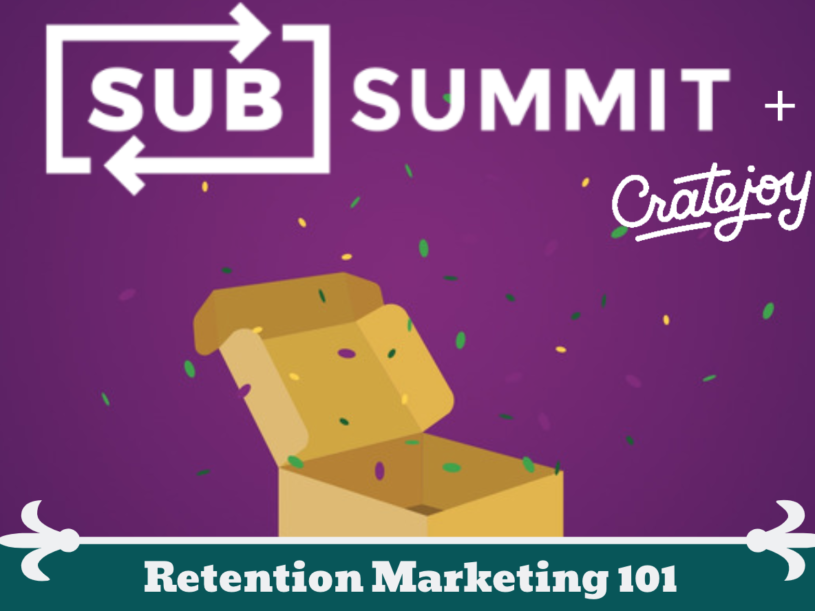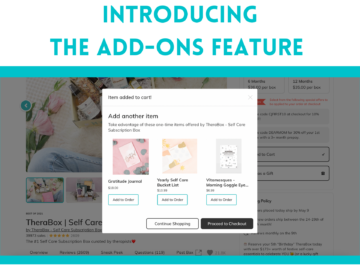Welcome to Part 2 of our SubSummit 2019 overview! Today, we’ll discuss Retention Marketing 101 with successful box businesses Southern Scholar, Smartass and Sass, Snail Mail for Kids, and Faithbox.
Why Retention Marketing Matters
“Retention marketing” is a phrase that gets tossed around when you work in a consumer-facing business, especially a subscription-based one. Essentially, it refers to specific marketing strategies you adopt to retain current subscribers – and win back churned customers, too. It’s crucial you develop plans for these segments of your audience because once you acquire someone as a subscriber, their needs and expectations will change.
Because churned subscribers usually leave for specific reasons, it’s important to learn why that is and meet each of those reasons individually. In other words? Listen to your customers, then adapt.
How This Worked for Our Panelists
For instance, popular box Smartass and Sass found that in their first year, they had a high volume of churn. Subscribers felt that the value of products included in the box didn’t meet what they were paying. So the business decided to handcraft a flagship product – a clever, snarky T-shirt – each month and communicate more clearly their commitment to showcasing small businesses in their boxes. “We asked subscribers their shirt preferences and tested the idea by offering shirts as an add-on for a given month.”
That approach has helped Smartass and Sass grow their subscriber base significantly: now, “big” boxes with the T-shirt included make up 60% of their orders.
“For cancelled subscribers, we focus on messaging new features, specifically things that have been common cancellation reasons. Customer feedback is crucial, and in our first year it definitely helped us fine-tune our products.”
Abby, Smartass and Sass
Southern Scholar, a direct-to-consumer menswear box that specializes in unique, stylish dress socks, has developed a marketing flow for each of these audiences. “Building out funnels or marketing flows that answer all of their potential questions in steps, rather than bombarding them with a ton of information off the bat, often leads to larger purchase windows but higher conversion rates and LTV,” says Kevin, the brand’s founder and CEO.
Their listening-based approach means they customize their retention marketing to fit consumer needs. “If they loved it but cancelled due to monetary reasons, it probably isn’t a great strategy to follow up with them in 30 or even 60 days,” Kevin points out. “If it was a gift subscription for Valentines Day and their feedback was positive, we are likely to follow up at either Father’s Day, Christmas, or both depending on when their first gift expired. If a subscriber cancels due to something that we’ve since improved, we are likely to offer them their first month free to experience the improvement for themselves.”
“Timing, messaging, and value prop needs to be tailored specifically for who you are targeting. Use your data.”
Kevin, Southern Scholar
How to Build a Retention Marketing Strategy
Each of our four panelists approaches marketing for retention a little bit differently. Southern Scholar looks at it in terms of principles; Smartass and Sass, communication; Snail Mail for Kids, brand identity; and Faithbox, community-building.
“I am marketing to two customers, the parent with the value and the child with the branding,” explains Wendy of Snail Mail for Kids, a weekly subscription for fun, educational letters from Sunny the Mail Snail. “It’s all about creating an experience and not just selling a product or products… My company is entirely built around a character I created, so it’s bringing that character to life for the kids.” For that reason, Snail Mail’s excellent customer service and Sunny’s friendly personality are linked.
“Yes, I may have paid $35.00 for an overnight FedEx for a missing letter, but that customer ended up staying with me for another year instead of canceling. Yes, I sent a free stuffed animal to Singapore, which cost me quite a bit of money, but that customer immediately changed from a monthly customer to prepaying for an entire year.”
Wendy, Snail Mail for Kids
Since Faithbox’s product curation is based around an overall experience, they offer additional places for fans to connect. “We have a private Facebook group for subscribers only, and we use daily emails to take everyone through the same devotional each day.”
“People are less likely to leave a community with which they identify and with whom they communicate regularly.”
Brandon, Faithbox
Additionally, Faithbox has a tactical plan for retention as well. “We built an interstitial page into the cancellation flow that offers alternatives,” Brandon says, like skipping a month, downgrading the subscriber’s box, or talking to the Faithbox support team. “We also send an email a few days after a person cancels with a personal message and a request for feedback.”
Listen to Your Subscribers
If you research retention marketing strategies, you can find all kinds of ideas. But only your subscribers will be able to tell you which work for them!
Smartass and Sass, for example, found that traditional strategies like referral campaigns did not connect with their customers. “When it wasn’t performing well after a few tweaks, we finally looked at the data and asked subscribers. It turns out less than 3% were even utilizing the program (and less than 1% were getting rewards) because the reality was that, overall, our subscribers just weren’t interested in a referral campaign.”
“With this insight, we instead opted to beef up on [our] loyalty campaign, which has been a huge success.”
Abby
Personalization – whether in your communications or the actual products offered in your box – can also help retain subscribers. This approach shows that you see the subscriber as an individual, rather than an order ID. “We keep our customers by creating an experience,” Wendy says of Sunny the Mail Snail’s weekly letters, “and we create an experience by making it personal.”
Southern Scholar agrees: “Personalization is huge for retention and for bringing churned/expired subscribers back,” Kevin says. Some ways Southern Scholar shows their appreciation of customers are by following up with them after they leave a review, commenting on their social media posts, and directly thanking them for their support.
“We have customers who we have never met but [we] know their kids’ names, what they do for work, where they go to school… ”
Kevin
For Smartass and Sass, personalization boils down to product offerings rather than communicating support. Not only do they include a printed gift message in every box going to a giftee, but they offer add-ons and different subscription tiers as well. “[E]ach month we have a specific item that fits our theme that any subscriber can add to their shipment, plus they get 20% off,” Abby tells us. This monthly bonus, as well as their 3 subscription tiers, allows customers to adapt their box according to their changing needs.
Final Takeaways
“You need four pillars to retain: love, value, word of mouth, repeat.”
Wendy
We asked our panelists what they would recommend to new subscription box entrepreneurs as they begin to consider retention. “[Y]ou can experience very high churn rates if you are primarily targeting people that are only attracted because it is a good deal,” Kevin points out. While a bargain is great for acquiring customers, it can be problematic for retention. So finding the right sales channels for your particular niche is important. “Find people who love your product/industry/theme and use the cost savings as the additional value prop[osition], not the main one.”
Wendy emphasizes customer support as her biggest retention tactic: “Extraordinary Customer Service is number 1. Always. No exceptions.” Because Snail Mail has lower overhead and a straightforward product offering, rather than a curated box of goods, customer support and personalization – making the customer feel special – is where they really shine. Their value proposition is in the experience.
“Really think hard about whether it’s possible to extend the experience you provide outside the box, so that your product becomes a part of the customer’s life instead of just a ‘box of cool stuff’ that arrives periodically.”
Andy
Faithbox agrees that the experience, not so much the products themselves, is key. “Are there opportunities for gathering people electronically (or physically!) to discuss the boxes and related topics?” Andy suggests. “Are there resources or content you can offer for subscribers who want to ‘go deeper’? Can you create continuity projects that require items from multiple boxes to complete?”
Lastly, Smartass and Sass reminded us that the best thing you can do is still to listen to your subscribers. Adaptability builds success more than anything. “[I]f you constantly have your pulse on their thoughts and reactions of your audience, you can pivot easily,” Abby says. Especially for small, brand-new businesses, it’s crucial to reevaluate your operations or strategies based on customer feedback. From that, you’ll gain a clearer idea of what they want – and know how to keep them coming back each month.
Want more?
Download a PDF of the full interview with these merchants here, then take a look at our other SubSummit panel discussion here.



